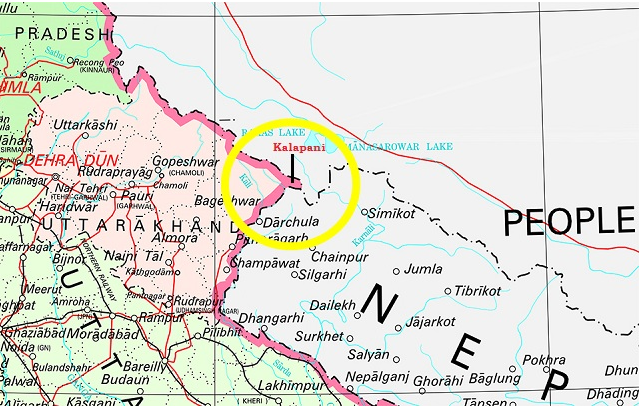Diplomatic Low In Indo-Nepal Relations | 26 May 2020
This article is based on “Lower the temperature, defuse the issue” published in The Hindu on 23/05/2020. It talks about recent diplomatic tussles between India and Nepal over the boundary dispute issue.
Recently, the Nepal government referring to the Treaty of Sugauli, 1816, took a decision to adopt a new political map that claims Indian territory of Lipulekh, Kalapani and other areas, as a part of Nepal.
Further, India Indian Army Chief’s contention that Nepal raised the dispute at the “behest of an external force”, namely China. These developments over the Kalapani territorial issue appears to threaten the basis of their special relationship, which has nurtured open borders and the free movement of people.
In this context, India must realize the importance of Nepal and quickly take diplomatic efforts to resolve this impasse.
What is the Issue?
- Kalapani is a valley that is currently administered by India as a part of the Pithoragarh district of Uttarakhand.
- The Treaty of Sugauli concluded between British India and the Kingdom of Nepal in the year 1816, states the Kali River in the Kalapani region demarcates the border between India and Nepal.
- Also, the Survey of India maps since the 1870s showed the area of Lipulekh down to Kalapani as part of British India.
- First, Rana rulers of Nepal and later Nepalese Kings accepted the boundary and did not raise any objection with the government of India after India’s Independence.
- However, in recent times, the Nepalese contest that the tributary that joins the Mahakali river at Kalapani is not the Kali river. Nepal now contends that the Kali river lies further west to the Lipulekh pass. This results in a boundary dispute between India and Nepal.
- For India, the Lipulekh pass has always been part of the road to Tibet and was mentioned as one of the border passes for trade in a 1954 agreement with China, which was also reaffirmed in another trade agreement in 2015.
- In 2019, a new political map of India, made after the bifurcation of the state of Jammu and Kashmir (J&K) into the Union Territories of J&K and Ladakh, showed Kalapani, Lipulekh and Limpiyadhura as part of Pithoragarh district in Uttarakhand state.
- Nepal protested strongly against India’s “unilateral” act and opinionated that the issue should be resolved through negotiations.
- Further, the inauguration of a road up to Lipulekh Pass by the Indian government on the border with China has sparked more protests in Nepal.
- In retaliation, Nepal has released a new map that includes all the disputed territories, which India has described as “unjustified cartographic assertion”.
Importance of Nepal For India
- Nepal lies in the middle of India’s ‘Himalayan frontiers’, and along with Bhutan, it acts as northern ‘borderland’ flanks and acts as buffer states against any possible aggression from China.
- Nepal shares borders with 5 Indian states- Uttarakhand, Uttar Pradesh, West Bengal, Sikkim and Bihar and with free movement of people and thereby acting as an important point of cultural and economic exchange in India-Nepal relations.
- Rivers originating in Nepal feed the perennial river systems of India in terms of ecology and hydropower potential.
- Many Hindu and Buddhist religious sites are in Nepal making it an important pilgrimage site for a large number of Indians.
China Factor In Indo-Nepal Relations
- In the past, Chinese interest in Nepal was to ensure that Nepalese territory is not used by Tibetans for the breeding of discontent.
- However, in recent times, China has made inroads into Nepal in infrastructure, education and health sectors. Also, Nepal wants to take advantage of the BRI project built by China.
- India feels that the Chinese inroads into Nepal are necessarily to counterbalance the Indian influence in Nepal. However, Nepal has asserted that its relationship with China is purely economic and will not be hurting the Indian strategic interests in any way.
- Also, India is of the view that the rising Nepal and China cooperation would undermine Nepal’s distinction of buffer state between India and China.
Way Forward
Although the people-to-people relationship between India and Nepal is unmatched, in recent times the not so good government-to-government relationship has curated many issues. In this context:
- India should stop looking at Nepal purely through a security prism, and at bilateral relations only as transactional and part of a zero-sum game with China.
- India should focus on working towards multifaceted relationships to the advantage of both nations.
- India should negotiate diplomatically to resolve the boundary dispute with Nepal under the aegis of International law on Trans-boundary Water Disputes. In this case, boundary dispute resolution between India and Bangladesh should serve as a model for this.
- India should maintain a policy of keeping away from the internal affairs of Nepal, while at the same time, in the spirit of friendship, India should guide the nation towards a more inclusive democracy.
Boundary disputes are common ground for countries that have an ancient history and shared borders, and the India-Nepal border issues one such dispute. Thus, the two neighbouring countries should not let the war of maps deteriorate their historical ties.
|
Drishti Mains Question “Boundary disputes have remained the Achilles heel in India’s Neighbourhood policy”. Discuss the statement in the context of the recent diplomatic tussle between India and Nepal. |
This editorial is based on “Cold Neighbourhood” which was published in The Hindu on May 23rd, 2020. Now watch this on our Youtube Channel.

